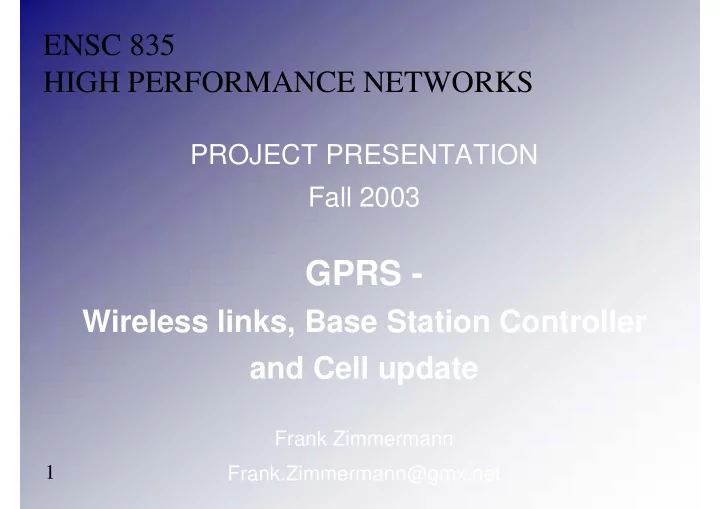

ENSC 835 HIGH PERFORMANCE NETWORKS PROJECT PRESENTATION Fall 2003 GPRS - Wireless links, Base Station Controller and Cell update Frank Zimmermann 1 Frank.Zimmermann@gmx.net
Roadmap Project goals GPRS overview GPRS cell update Implementation Simulation Future work References 2
Project goals Enhance the existing GPRS OPNET model Replace wired conncections with wireless links Implement the Base Station Controller Simulate the cell update Verify the implementations through simulations 3
GPRS - General Packet Radio Service GPRS is an addition for packet switching to the Global System for Mobile communication (GSM) GSM and GPRS are standardized by the European Telecommunications Standards Institute (ETSI) GSM is a connection oriented service, which uses FDMA, TDMA and supports 9.6 kb/s GPRS supports up to 171.2 kb/s through multislot capability and different channel coding schemes 4
Advantages of GPRS Limited bandwith is used more efficiently Users can be billed by traffic volume instead of time “Always on connection” GPRS is suitable for upcoming applications: Navigation systems with up to date maps and traffic messages WAP (Wireless Application Protocol), Location based services Email, Instant messaging 5
GPRS Network HLR BT S External MSs BSC SGSN GGSN IP Network BT S MS: Mobile Station BTS: Base Transmitter Station BSC: Base Station Controller HLR:Home Location Register SGSN: Serving GPRS Support Node 6 GGSN: Gateway GPRS Support Node
GSM - Frequencies Frequencies: 900 MHz and 1800 MHz, 1900 Mhz in North America PCS (Personal Communication System) 1900: Uplink (MS ? BTS) 1850.2 MHz ? 1909.8 MHz Downlink (BTS ? MS) 1930.2 MHz ? 1989.8 MHz Channel Bandwidth 200 kHz Each BTS can use a set of frequencies Uplink and downlink frequencies are used in pairs The first frequency of a BTS is also called BCCH (Broadcast control channel) frequency, because the BCCH is transmitted in one of the timeslots The BCCH frequency is used by the MS for channel 7 measurements
MS GMM States IDLE GPRS attach GPRS detach READY READY timer expiry or PDU transmission Force to STANDBY STANDBY GMM: GPRS mobility management 8 PDU: Packet Data Unit
Cell update (1) The MS has to perform channel measurements of up to 32 BTSs at least every 5 seconds It maintains a table with the 6 best BTSs A cell update has to be performed if the reception from another BTS is better than from the current one 9
Cell update (2) In GSM the MS sends the measurements to the BSC which makes the decisions about a handover to another cell The GSM handover would cause a very heavy signalling burden for GPRS [4]. Therefore the cell update was introduced in GPRS: A MS in Ready State sends a Link Layer Control (LLC) frame from the newly selected cell to inform the SGSN about the new location In Standby State the SGSN is not informed, the SGSN has to page the MS if it wants to send downlink data to a MS in Standby 10 State
Implementation (1) OPNET Project: 11
Implementation (2) BSC Node Model: 12
Implementation (3) MS Node Model: 13
Simulation Measure the End-to-End delay from the MS to the sink and the throughput and compare the results with the previous GPRS model without BSC and wireless links to verify the implementation Simulate cell updates between different BTSs with mobile nodes and observe the behaviour of the network The End-to-End delay should increase because of the implementation of the BSC 14
Future work Finish the OPNET implementation and run simulations Implementation of the MAC/RLC layers Run simulations with genuine traffic traces Implemention of additional QoS classes MAC: Medium Access Protocol RLC: Radio Link Control QoS: Quality of Service 15
References [1] Emmanuel Seurre, Patrick Savelli, Pierre-Jean Pietri, GPRS for Mobile Internet, Artech House, 2003 [2] Christoffer Andersson, GPRS and 3G Wireless Applications: Professional Developer's Guide , John Wiley & Sons, 2001 [3] Digital cellular telecommunications system (Phase 2+);General Packet Radio Service (GPRS) Service description;Stage 2 (3GPP TS 03.60 version 7.9.0 Release 1998) [4] Gunnar Heine, Holger Sagkob, GPRS Gateway to Third Generation Mobile Networks , Artech Housse, 2003 [5] Jukka Lempiainen, Matti Manninen, Radio Interface System Planning for GSM/GPRS/UMTS , Kluwer Academic Publishers, 2001 [6] Ricky Ng, Ljiljana Trajkovic, ``Simulation of General Packet Radio, Service Network,'' OPNETWORK 2002 , Washington, DC, Aug. 2002 [7]Mikael Johansson, “Simulation of Logical Link Layer in GPRS”, Simon Fraser University , Burnaby, Spring 2003 16
Summary Project goals GPRS overview GPRS cell update Implementation Simulation Future work References QUESTIONS? 17
Recommend
More recommend